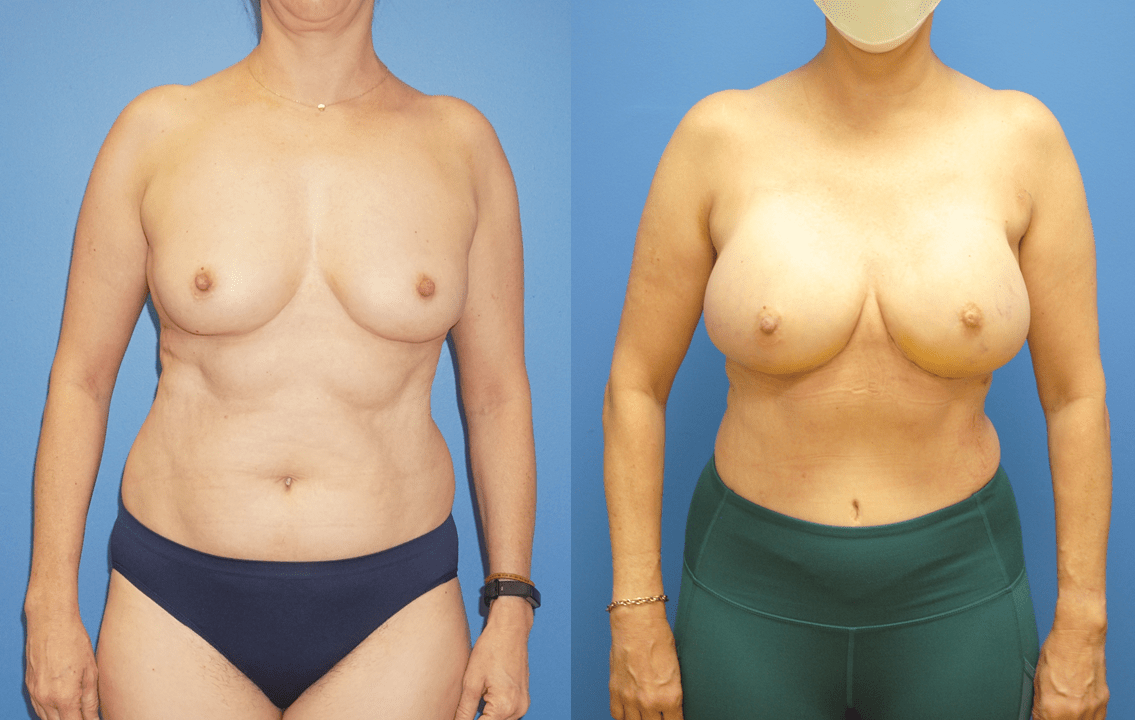Lumpectomy defects can be reconstructed with the same techniques used to make the breast appear more youthful. The same techniques can be used to correct a deformity in the breast following radiation therapy.


Lumpectomy defects can be reconstructed with the same techniques used to make the breast appear more youthful. The same techniques can be used to correct a deformity in the breast following radiation therapy.

DIEP flap reconstruction can be used to reconstruct the breast in patients who have undergone radiation who are no longer candidates for implant reconstruction. In the radiated breast, the skin may not tolerate an implant or may be more susceptible to infection. In these patients the breast is reconstructed with the patients own body tissue. This photos shows a bilateral…

DIEP flap breast reconstruction uses the tissue from the lower abdomen to reconstruct the breast. This allows a natural match to the other breast. What can determine if a patient is a candidate for DIEP flap breast reconstruction is the amount of tissue on the lower abdomen and presence or absence of abdominal scars from previous surgeries. The satisfaction rate…

There are several common procedures that are performed that can help provide a youthful appearance to the face. One of the more common procedures performed in younger patients is a lower blepharoplasty procedure. In the lower blepharoplasty procedure, the lower eyelid is gently retracted inferiorly and the fat is removed from three compartments in the lower lid. This is one…

Patients with breast implants may encounter capsular contracture. Some patients may get capsular contracture repeatedly. In patients with capsular contracture we recommend removal of the mammary prosthesis. Often patients do not want do be completely done with their mammary prosthesis and we then encourage patients to have smaller mammary prosthesis replaced. It is often helpful to have the mammary prosthesis…

DIEP flap reconstruction is a common method of reconstruction. Occasionally the lower abdomen does not have sufficient tissue for a bilateral reconstruction and the flap reconstruction can be augmented with mammary prosthesis. Typically, we wait until one year after a DIEP flap reconstruction to augment the breast. The satisfaction rate is high with augmentation of the DIEP flaps because the…

DIEP flap breast reconstruction is an excellent option for a unilateral mastectomy in a patient with the appropriate body habitus. The unilateral autologous reconstruction can match the contralateral breast well with respect to shape. Size can also be matched well, depending on the abdominal donor site. Autologous flap reconstructions tolerate radiation therapy well. This is a right unilateral DIEP flap…

Breast cancer in some patients can be successfully treated with lumpectomy and radiation. Often the same pattern used to make the breast appear more youthful can be utilized to reconstruct the breast and make it in a more suitable shape for radiation therapy to be more effective. When the tumor is in a location close to the skin and outside…

Abdominoplasty is an operation that can effectively help to improve the contour of the abdomen. There is a significant amount of healing and patient compliance post-operatively that is required with abdominal binders and JP drains. Protein nutrition is important and patients are instructed to consume 80-100 grams of protein daily to facilitate healing.

There are several decisions that come into account when performing an abdominoplasty operation. One is the quality of the skin on the abdominal wall and how much skin can be removed. This will sometimes determine the location of the lower abdominal skin incision and also whether or not the previous belly button opening can be excised. With significant amount of…

Bilateral implant breast reconstruction following bilateral mastectomy is a common procedure. The aesthetic outcome of the reconstruction is often determined by the quality of the mastectomy skin and the relation of the tissue characteristics and the implant. In patients who choose to undergo implant reconstruction I often indicate that the best outcomes and most durable reconstruction are the patients who…

In general implant mastectomy reconstruction takes place in two stages. At the time of the mastectomy a tissue expander is inserted beneath the pectoralis major muscle and a piece of acellular dermal matrix or Strattice is inserted to provide support to the tissue expander. There are times, albeit rare, when I proceed with immediate insertion of mammary prosthesis. Patients who…
